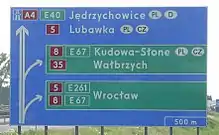Polish road signs typeface
Polish road signs typeface (Polish: Polskie liternictwo znaków drogowych) – geometrical typeface meant to making text on Polish road signs, according to Attachment 1 of Regulation on detailed technical conditions for road signs and signals as well as road safety devices and conditions for their placement on roads.[1] The regulation defines a construction of digits, all of the letters of Polish alphabet and the letter V (not including Q and X), and the punctuation marks: hyphen, round brackets, comma, full stop (period) and exclamation mark.

The typeface has been created by Marek Sigmund, who made the project commissioned by the state authorities in 1975, while the Instruction about road signs and signals (Polish: Instrukcja o znakach i sygnałach drogowych) was being implemented. The typeface has been designed in six weeks. According to the designer's assumptions, the typeface included creating text on boards by using the freehand and stencil techniques.[2][3]
This typeface has poor readability when trying to read a small text while driving at high speed.[4][5]
Electronic versions
There are three fonts that imitate road signs typeface. Two of them are available as non-commercial freeware:[4][6]
- Liternictwo Drogowe – distributed by the company Centrum Rozwoju Explotrans S.A. that cooperates with Ministry of Infrastructure. It completely matches the Regulation. Meant mainly for the enterprises that produce road signs.
- Tabica drogowa – created in 2001 by Grzegorz Klimczewski. This version has all the markings that are defined in the Regulation and also additional ones (including Q and X letters). Some of not included marks (quotation mark, question mark, percent sign) have been replaced by arrows. At first, the font was distributed as a paid one but currently it is a non-commercial freeware.
- Drogowskaz – created in 2006 by Emil Wojtacki. Apart from the markings defined in the Regulation, it includes many more, designed in style of the original typeface, such as scribal abbreviations and diacritics used in various languages. The font is distributed as non-commercial freeware.
References
- Rozporządzenie w sprawie szczegółowych warunków technicznych dla znaków i sygnałów drogowych oraz urządzeń bezpieczeństwa ruchu drogowego i warunków ich umieszczania na drogach [Regulation on detailed technical conditions for road signs and signals as well as road safety devices and conditions for their placement on roads], Dz. U. z 2019 r. poz. 2311
- Misiak, Marian (2013), "Pismo Drogowe", FUTU Paper, no. 10/2013, p. 25
- Instrukcja o znakach i sygnałach drogowych, Warszawa: Wydawnictwa Komunikacji i Łączności, 1975
- Hermann, Ralf (2008), Traffic Sign Typefaces: Poland, archived from the original on 2012-07-13, retrieved 2011-06-18
- See the example of signpost announcing a junction on Warsaw southern bypass. The text of the information on the exceptions of tonnage (weight) limit on the sign is barely legible compared to the rest of the signpost.
- Liternictwo Drogowe – Czcionka TTF v4.1 (in Polish), Centrum Rozwoju Explotrans S.A., 2010-06-19, archived from the original on 2012-03-25